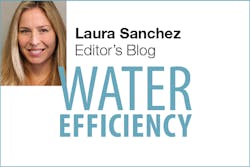During the recent drought, California farmers pumped so much groundwater that the water table dropped by 10 to 20 feet in some places, and up to 100 feet in others. Aquifers were depleted. Wells ran dry. And then, as if by some miracle, it rained.
This winter, storms have delivered rainfall from two to four times the average in California according to AccuWeather. More than 25 feet of snow has fallen over the high Sierra Nevada since mid-November, which translates to about 30 inches of water to be released into streams, reservoirs, and aqueducts. But storing this abundance of water for later use may prove challenging for the state.
Experts agree that groundwater storage represents a valuable solution to regional water storage needs. For one, it’s practical. California’s Department of Water Resources estimates the total groundwater storage capacity at somewhere between 850 million and 1.3 billion acre-feet. In comparison, surface storage from all the major reservoirs in California is less than 50 million acre-feet. Utilizing natural, subsurface storage is a logical solution.
It’s also cost effective. New research published by Stanford University’s Water in the West program shows that groundwater recharge is significantly less expensive—at a median cost of $390 per acre-foot—than surface storage options like reservoirs and tanks.
In order to replenish aquifers, surface water must find its way underground. Aquifers can be recharged naturally by way of rain, snow, and streamflow that soak into the earth, or artificially by channeling water into groundwater basins or by pumping water into aquifers.
Today, a group of farmers and researchers are attempting to help recharge the state’s aquifers by flooding fields. Flooded fields act like ponds that allow water to gradually permeate the ground and replace subsurface water.
“This is going to be the future for California,” Don Cameron, the general manager of Terranova Ranch, southwest of Fresno, California told NPR’s Dan Charles. “If we don’t store the water during flood periods, we’re not going to make it through the droughts.” Over four months, Cameron flooded his fields with water—equivalent to three feet deep across 1,000 acres. “We started in February, and we flooded grapes continuously, for the most part, until May,” Cameron said. It all went into the ground, and didn’t seem to adversely affect his vines.
Helen Dahlke, a groundwater hydrologist at the University of California, Davis, and her team has set up test sites on almonds, pistachios, and alfalfa to test the effect of flooding on crops. “We really have to find new ways of storing and capturing rainfall in the winter, when it’s available,” says Dahlke. And there’s no better place, it seems, to safely and cost-effectively store water than underground.
What are your impressions of this diluvial method of aquifer recharge?

